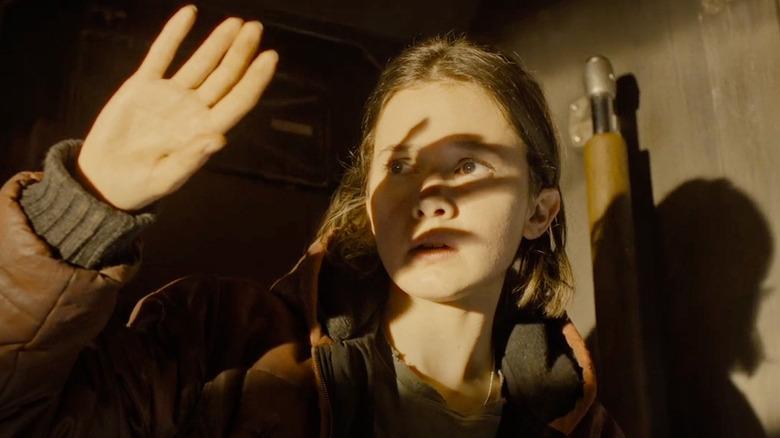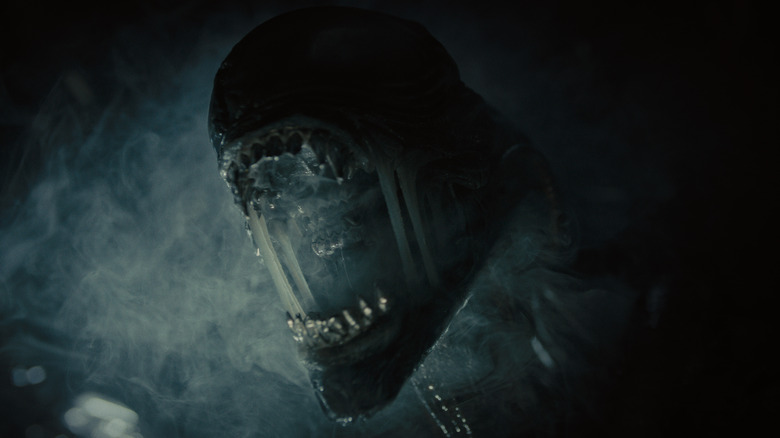Alien: Romulus Cleverly Reveals A New Part Of Xenomorph Lore
In space, no one can hear you spoil the latest "Alien" movie. Be warned, this article discusses major spoilers from "Alien: Romulus."
After well over 40 years of seeing the "perfect organism" in all its various forms on the big screen, including a convoluted origin story covered in both of Ridley Scott's divisive prequels "Prometheus" and "Alien: Covenant," it was fair to wonder how another franchise installment like "Alien: Romulus" (read /Film's review) could possibly make the dreaded Xenomorph scary again. Every possible facet of the sentient mechanical-biological weapon seemed to have been explored by now, from its flawless introduction in the 1979 original to the introduction of the queen in "Aliens" to the animal hybrid of "Alien 3." (Though I defend it more than most, the less said about "Alien Resurrection" and its, ah, unique addition to Xeno-morphology, the better.) So, what was left for director Fede Álvarez to explore this time around?
Luckily for us all, "Romulus" goes back to the franchise's roots (according to many of the early reactions to the film), drew directly from what the first "Alien" movie left to the imagination, and expands on Xenomorph lore. The sequel follows a fresh-faced cast led by Cailee Spaeny's Rain, her synthetic "brother" Andy (David Jonsson), and a motley crew of friends who soon become victims. While they trespass onto a derelict space station in orbit around their planet and inadvertently unleash the same type of horror that Sigourney Weaver's Ellen Ripley once narrowly survived, Álvarez's script (also credited to co-writer Rodo Sayagues) makes its boldest move yet and expands on the lifecycle of the franchise's main villain.
In the span of a few chilling scenes, "Alien: Romulus" makes its big bad feel terrifyingly new and unknowable all over again — simply by revealing brand-new layers to the Xenomorph lore.
Alien: Romulus reveals the missing link between facehuggers, chestbursters, and Xenomorphs
Despite all the ground covered in "Alien" and its subsequent sequels, one relatively significant aspect of the Xenomorph life cycle has remained stubbornly hidden from view. We know through the deaths of Kane (John Hurt) in the original movie, Navarro (Aileen Wu) in "Alien: Romulus," and many others that the vicious cycle begins with a facehugger implanting hapless victims so that a chestburster can, well, burst forth. In a very short amount of time, these nasty fellas then grow into full-sized Xenomorphs ... but we've never actually seen how that happens.
All that finally changes in "Romulus" when the unpleasant, synthetic-discriminating Bjorn (Spike Fearn) and Kay (Isabela Merced) accidentally stumble upon one of the weirdest and grossest sights that Álvarez has up his sleave. After Navarro's chestburster kills her and scrambles away, wrecking the getaway ship and leaving our protagonists without a clear way off the space station before it's destroyed, her surviving friends come across what appears to be a massive cocoon ensconced on a nearby wall. The brilliant Bjorn decides on the absolute worst course of action and promptly uses his stun baton to kill whatever might be growing inside. This seems to work — until Bjorn gets a face full of acid for his troubles and dies an excruciating death. What comes out afterwards, of course, is nothing less than a full-grown Xenomorph.
In the process, this fills in the missing link between the teeny-tiny chestburster and the Xenomorphs that can reach upwards of seven feet in height. Wonder no more about how that growth spurt happens; like a f***ed up butterfly straight from hell, its biggest transformation apparently occurs within that cocoon. How's that for some creepy new lore?
"Alien: Romulus" is now playing in theaters.

